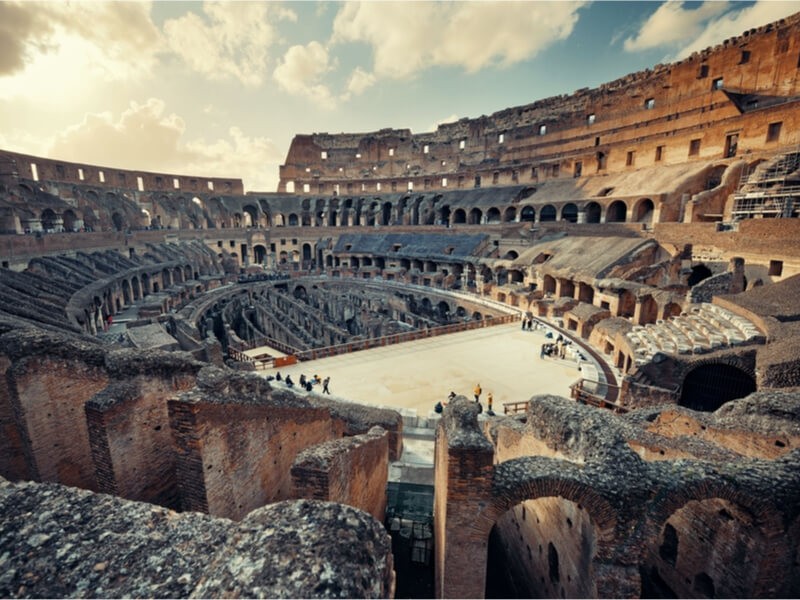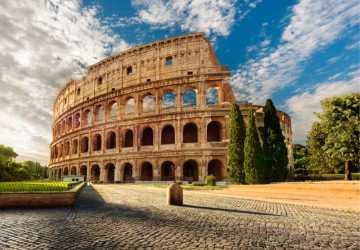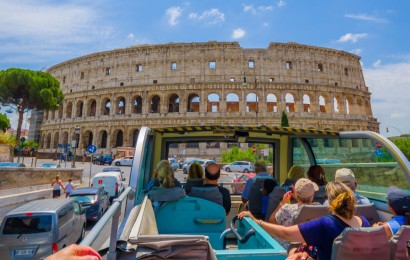The Colosseum (also known as the Flavian Amphitheatre) is an imposing building that rises in the archaeological area of the city of Rome. It was commissioned by the emperor Vespasian in 70-72 A.D. and inaugurated, on the death of Vespasian, by his son Titus in 80 A.D.
It has become over the centuries the largest Roman amphitheater.
In ancient times it was used for gladiatorial shows and other events, such as hunting shows and dramas on classical mythology, such as the famous naumachiae.
The naumachiae were naval battles, which the Romans set up as real shows, with richly decorated ships and maneuvered like real ships in battle.
The goal was to reproduce the famous historical battles, following in detail all the various stages, while the audience in a frantic way exalted the victories and defeats.
The large arena in the center of the Colosseum, was covered with sand, filled with water directly coming from 3 large cloache and the part below it was called hipogeo, to indicate a complex system of tunnels and rooms where the gladiators stayed, the condemned and the animals.
The games were not only an opportunity for recreation, but also a time when people, institutions and powers met. Thus, the deepening of the division between classes is reflected in the rules on the rigid division of places in places of entertainment. Let’s find out together how they were distributed.
The seats on the bleachers of the Colosseum were assigned according to social class:
- the podium, with wide and low steps was reserved for senators, priests, senatorial families, consuls and magistrates;
- the maenianum primum, was reserved for aristocrats;
- the maenianum secondum was reserved for citizens and divided into imum for the rich and summum for the poor;
- the maenianum summus in ligneis, was instead the sector that Domitian had reserved for women.
From this division you can see how as you go up and so the arena could be seen further away, the seats were assigned to less important people. Many fragments of the marble seats bear the inscription of the class for which they were intended.
--> Book a guided tour of the Colosseum and immerse yourself in the history of Rome.
10 interesting facts about the Colosseum

The anecdotes, legends and curiosities about the Colosseum are many, let’s discover some together:
- The opening ceremony of the Colosseum lasted 100 days.
The Colosseum was inaugurated by the Emperor Titus without paying any attention: 100 days of shows, fights and historical performances were organized; - It is the largest amphitheater in the world, 189 meters long and 156 meters wide, covering an area of about 24000 square meters;
--> Want to know everything about Rome? Don’t miss our guide to the most important monuments of Rome - Inside it died about 500000 men and 1 million animals;
- Originally the Colosseum was adorned with statues, friezes and marbles.
It is called Colosseum because of an imposing statue in the vicinity: the "Colossus of Nero"; - The Colosseum was the set of numerous films. However, due to some setbacks, the film that really made the Colosseum famous was not filmed here: "The Gladiator;
- On sunny days the Colosseum was covered by a large frame composed of 80 triangular sails and 320 support ropes. The frame (velarium) had the function of avoiding insolation to the spectators during the shows held in the hottest and sunniest hours;
- Among the ruins of the Colosseum, have grown spontaneously more than 350 species of plants including some also of exotic origin; in fact before that in the nineteenth century archaeologists and engineers cleaned it up, the Colosseum was covered with plants and trees that for a long time were cultivated to gardens and gardens and a great variety of vegetation grew in the shadow of the arches;
- Inside the Flavian Amphitheater in the thirteenth century was built a palace in which resided the Frangipane family, a noble and powerful Roman family;
- In 1980, it was listed as a UNESCO World Heritage Site. And on July 7, 2007, he joined the New Seven Wonders of the World;
- The gladiatorial spectacles were abolished in 438 by Valentinian III and this meant the beginning of the decline of the Colosseum, to the point that in the Middle Ages it was almost totally forgotten. To it were even attributed macabre characteristics, since it was considered as one of the gates of hell. In the following centuries, the Colosseum became a kind of quarry and almost all the marble used for its construction was taken and used for other buildings, such as the Basilica of San Pietro and Palazzo Barberini.

